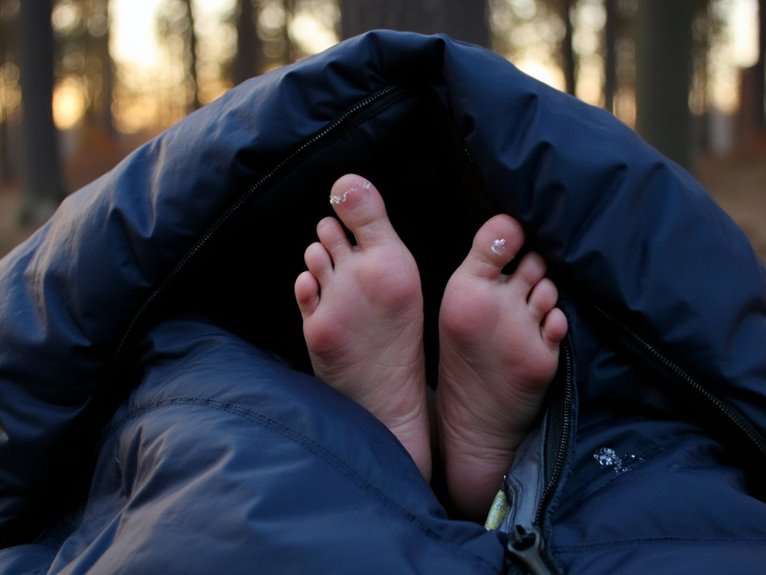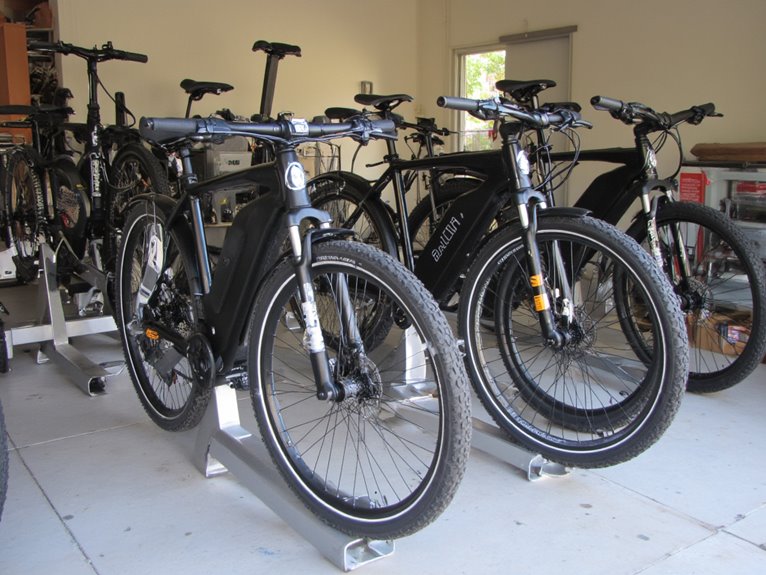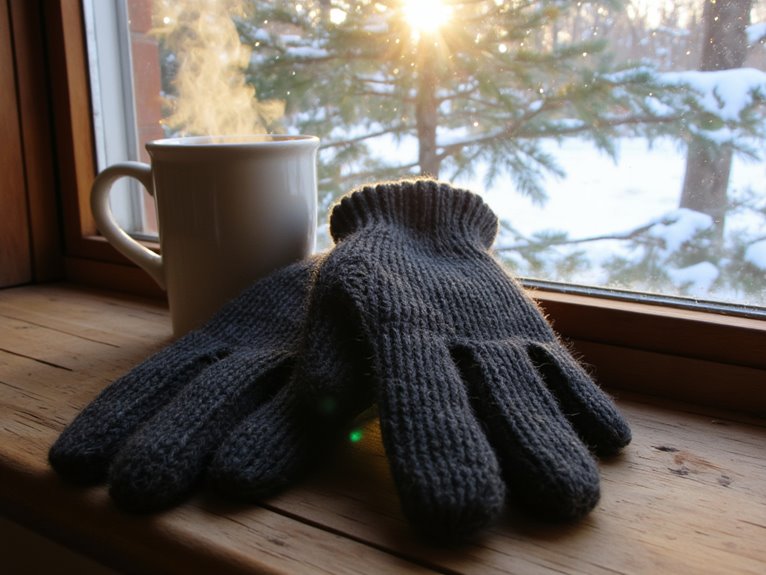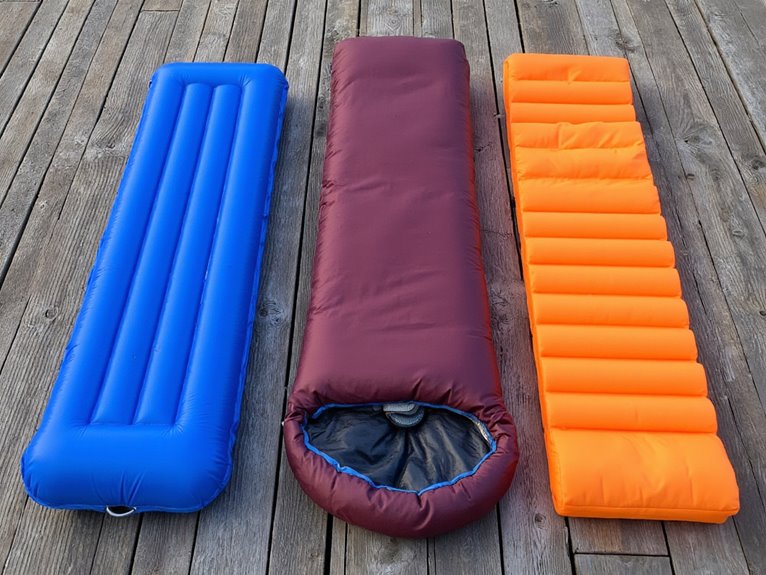How to Avoid Cold Spots and Cold Feet in Your Sleeping Bag
You’ll prevent cold spots and cold feet by selecting a mummy-style sleeping bag with proper baffle design, using an insulated sleeping pad with an R-value above 4, and positioning your campsite behind natural windbreaks. Wear dry wool or synthetic base layers, avoid cotton clothing, and make certain your feet are warm before entering the bag. Add a sleeping bag liner for extra warmth and maintain 6-8 inches from tent walls to prevent condensation buildup that compromises insulation effectiveness and creates those frustrating cold zones that’ll keep you awake.
We are supported by our audience. When you purchase through links on our site, we may earn an affiliate commission, at no extra cost for you. Learn more. Last update on 9th December 2025 / Images from Amazon Product Advertising API.
Notable Insights
- Choose a mummy-style sleeping bag with proper baffle design and draft collars to minimize dead air space and prevent insulation migration.
- Use an insulated sleeping pad with R-value above 4 and consider double-layer foam pads to create thermal barriers against ground cold transfer.
- Camp in wind-protected areas using natural features as windbreaks, avoiding cold air basins and depressions where temperatures accumulate.
- Wear clean, dry wool or synthetic base layers and warm your feet before entering the bag to prevent moisture buildup.
- Manage ventilation by opening foot zippers or vents for airflow while maintaining distance from tent walls to prevent condensation.
Understanding Sleeping Bag Anatomy and Design Features
When you’re dealing with cold spots in your sleeping bag, the root cause often lies in the bag’s fundamental design and construction.
Different sleeping bag types affect thermal performance considerably. Mummy bags minimize air pockets through their tapered design, while rectangular bags create more dead air space that your body must heat.
Mummy bags excel at thermal efficiency by eliminating excess air space that rectangular designs force your body to warm.
Insulation materials play a vital role in heat distribution. Down insulation provides superior warmth-to-weight ratios but compresses under pressure points, creating cold zones. Synthetic insulation maintains consistent loft but weighs more.
Baffle design determines how insulation moves within the bag. Well-constructed baffles prevent insulation migration and cold spots. Draft collars around the neck and zipper draft tubes eliminate thermal bridges.
Foot box design affects circulation and warmth retention in your extremities.
Hybrid insulation combines the warmth-to-weight benefits of down with synthetic materials’ moisture resistance, retaining 80-90% loft in wet conditions compared to down’s significantly reduced performance when damp.
Selecting the Right Campsite and Environmental Protection
Your campsite selection directly impacts sleeping bag performance and cold spot formation.
Wind exposure, elevation changes, and terrain features create temperature variations that penetrate even high-quality insulation systems.
You’ll need to evaluate wind protection strategies, understand how altitude affects ambient temperatures, and position your shelter to work with natural terrain advantages.
Wind Protection Strategies
Wind exposure creates the single greatest threat to sleeping bag performance, transforming even premium insulation into ineffective barriers against heat loss.
You’ll need thorough wind barriers to protect your thermal layers from convective cooling. Position your tent’s lowest profile toward prevailing winds.
Pitch shelters extremely low, securing edges with buried stakes or guy-lines tensioned at 45-degree angles. Close all vents during wind events—even small openings create significant drafts.
Construct layered windbreaks using natural features like rock formations or dense vegetation.
Build artificial barriers with tarps, snow walls, or stacked logs around your shelter perimeter. These create calm air pockets that reduce wind chill effects by 60-80%.
Select campsites in terrain depressions or behind ridgelines where wind velocity decreases naturally.
Avoid exposed summits and valley floors where katabatic winds funnel cold air downslope.
Altitude and Temperature
Effective windproofing becomes even more critical as elevation increases, where temperature drops create compounding thermal challenges that can overwhelm your sleeping system.
Altitude impact follows a predictable pattern: temperature drops 6.5°C per 1,000 meters of elevation gain. This dramatic temperature fluctuation demands strategic campsite selection and proper gear ratings.
Your sleeping bag rating must account for altitude-specific conditions:
- Choose locations near natural windbreaks – rock walls and dense vegetation retain precious heat overnight
- Avoid camping in basins or depressions – cold air pools in these areas, creating dangerous temperature traps
- Select bags rated 10-20°F below expected lows – altitude’s reduced air density accelerates heat loss from your body
Above treeline, temperature swings intensify dramatically.
Lower valleys retain warm air through temperature inversion, while exposed ridges experience brutal cold drafts.
Shelter and Terrain
While sleeping bag insulation provides your primary thermal protection, strategic shelter placement and terrain selection create the microenvironment that determines whether your gear performs as intended.
Cold spots develop when you camp in drainage bottoms, which trap dense air and increase humidity levels by 15-20%. Shelter types like geodesic tents offer superior wind resistance, maintaining interior temperatures 8-12 degrees warmer than exposed positions.
Effective terrain selection requires avoiding low-lying areas where cold air accumulates. Position your shelter on elevated, flat ground with natural wind barriers.
Face your tent’s back wall toward prevailing winds to minimize heat loss through the floor. Choose stable soil conditions and assess the microclimate for temperature variations that could compromise your sleeping system’s thermal efficiency throughout the night.
Essential Accessories for Ground Insulation and Warmth
Beyond your sleeping bag’s insulation, strategic ground accessories form the critical barrier between your body heat and the earth’s relentless cold transfer. Insulation materials like reflective foam pads create thermal barriers with R-values ranging from 2-8, depending on thickness and construction.
Strategic ground accessories create the critical thermal barrier between your body heat and the earth’s relentless cold transfer.
Double-layering a closed-cell foam pad under your primary air mattress eliminates thermal bridging through contact points.
Essential accessories that prevent heat loss include:
- Sleeping bag liners adding 5-15°F warmth while weighing under 8 ounces
- Thermal ground cloths reflecting 97% of radiant heat back to your body
- Insulated sleeping pads with R-values above 4 for sub-freezing conditions
Draft stoppers seal gaps around zippers and foot boxes.
Camping on elevated, well-draining terrain reduces ground moisture that accelerates conductive heat loss through your sleep system.
When setting up your sleeping pad, clear the ground of sharp objects and debris to prevent damage while ensuring your thermal barrier remains intact throughout the night.
Targeted Techniques for Preventing Cold Feet
Your feet are typically the first body part to lose heat in a sleeping bag because they’re positioned at the bag’s foot box where insulation is often thinnest and compressed.
Adding dedicated insulation under your feet creates a thermal barrier between you and the cold ground, while warm socks provide an additional layer of dead air space for heat retention.
These two fundamental strategies work together to maintain foot temperature by preventing conductive heat loss through the sleeping bag’s bottom and preserving your body’s natural warmth through effective layering.
Mummy-style bags enhance heat retention compared to rectangular designs, making them particularly effective at preventing cold feet by reducing the overall air space that your body needs to heat.
Insulation Under Feet
Since your feet sit furthest from your core and closest to the cold ground, they’re often the first body parts to lose heat in a sleeping bag. Proper ground coverage beneath your feet creates a critical thermal barrier that prevents heat loss through conduction.
Match your sleeping pad’s R-value to ambient temperatures for peak performance. Guarantee the pad extends fully under your feet, covering contact points at your heels and toes.
Consider these insulation materials for enhanced protection:
- Dual-layer setup: Place closed-cell foam under your inflatable pad for puncture protection and added warmth
- Natural emergency materials: Use pine boughs or leaves beneath your pad when commercial options aren’t available
- Luxury additions: Position fleece or wool blankets between your tent floor and sleeping pad
This layered approach maximizes thermal efficiency and eliminates ground-contact cold spots.
Warm Socks Benefits
While ground insulation forms the foundation of warmth, the right socks create a secondary thermal layer that directly impacts foot temperature throughout the night.
Thermal socks enhance warmth retention through thick insulation materials like merino wool, which trap warm air while maintaining breathability. These materials effectively wick moisture away from your skin, preventing the chilling effect of damp conditions.
Proper sock selection directly improves blood circulation to your extremities. Cold temperatures naturally constrict blood vessels, reducing heat delivery to your feet.
Quality thermal socks counteract this effect by maintaining consistent warmth around your feet. The insulation prevents vessel constriction, ensuring steady blood flow throughout extended periods in your sleeping bag.
This circulation support proves especially beneficial for individuals with conditions like Raynaud’s syndrome or diabetes-related circulation issues.
Proper Clothing and Personal Preparation Strategies
When preparing for cold-weather camping, the clothing you wear inside your sleeping bag directly affects your warmth throughout the night. Smart clothing choices start with selecting the right base layer materials. Choose wool or synthetic fibers that wick moisture away from your skin, avoiding cotton which retains dampness and reduces insulation effectiveness.
Your sleeping bag clothing choices make the difference between a comfortable night’s rest and hours of shivering in the wilderness.
Your pre-sleep preparation routine determines overnight comfort:
- Warm your feet thoroughly before entering the bag using foot warmers or active movement
- Change into clean, dry sleeping clothes to eliminate moisture buildup
- Wear loose-fitting layers to maintain proper blood circulation
Layer lightly enough to prevent sweating, as damp clothing compromises insulation performance. Use dedicated sleeping socks and consider adding a sleeping hat, since significant heat loss occurs through your head and extremities. Consider sleeping bags with spacious footboxes that prevent compression of insulation around your feet, which can create cold spots in these critical areas.
Managing Moisture and Ventilation
Moisture represents the single greatest threat to sleeping bag performance, capable of transforming even premium insulation into a cold, clammy nightmare. Your body produces approximately 1-2 pints of perspiration nightly, even during sleep. This vapor saturates insulation, reducing loft by up to 50% and creating cold spots where moisture accumulates.
Effective moisture management requires strategic ventilation techniques. Open foot zippers or shoulder vents partially to create airflow without excessive heat loss. Position your bag 6-8 inches from tent walls to prevent condensation transfer. Use breathable shell fabrics that allow vapor escape while blocking external moisture.
Deploy silk or fleece liners to wick perspiration away from insulation. Air out your bag daily for 15-30 minutes, allowing UV exposure to eliminate bacteria while preventing fabric degradation from extended sun contact.
Sleeping Bag Maintenance and Care Tips
Because your sleeping bag represents a significant investment in comfort and safety, proper maintenance directly impacts both performance and longevity. Effective sleeping bag care prevents insulation degradation and maintains thermal efficiency.
Proper sleeping bag maintenance preserves your investment by preventing insulation breakdown and ensuring optimal thermal performance for years of reliable use.
Wash annually or after 50 uses with non-biological detergent, avoiding fabric softener that damages down fibers. Use low heat tumble drying with additional rinse cycles to eliminate residue.
Essential sleeping bag care practices include:
- Protecting your investment – Use liners and ground pads to shield against body oils and abrasive surfaces
- Preventing heartbreak – Store in spacious, dry areas to maintain loft and prevent compression damage
- Avoiding disaster – Never dry clean down bags, as chemicals strip natural oils
Your maintenance routine should incorporate spot cleaning with non-detergent soap, regular inspections for wear, and proper storage techniques.
Professional services handle complex cleaning when necessary.
Keep water temperature below 40°C (100°F) during washing to prevent damage to both down and synthetic insulation materials.





